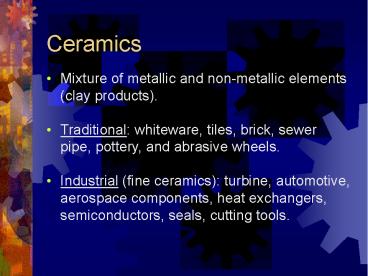Ceramics PowerPoint PPT Presentation
Title: Ceramics
1
Ceramics
- Mixture of metallic and non-metallic elements
(clay products). - Traditional whiteware, tiles, brick, sewer pipe,
pottery, and abrasive wheels. - Industrial (fine ceramics) turbine, automotive,
aerospace components, heat exchangers,
semiconductors, seals, cutting tools.
2
Ceramic Applications
- Electronic insulators
- Engine components
- Machining tools
- Porcelain
- Bioceramics for prosthetics
3
Structure of Ceramics
- The structure of ceramic crystals is among the
most complex of all materials. - Contain various elements.
- Covalent bonding (electron sharing), stronger
than metals. - Hardness, thermal, and electrical resistance
higher than metals. - Finer the grain size, higher strength and
toughness.
4
Ceramic Materials
- Clay (kaolin) silicate of aluminum.
- Flint fine-grained silica.
- Feldspar aluminum silicates, potassium,
calcium/sodium.
5
General Properties of Ceramics
- Mechanical Properties
- Much stronger in compression vs. tension (one
magnitude difference) - Sensitive to cracks, impurities, porosity
- Lack toughness, ductility, are brittle and strong
- static fatigue failure (load over a period of
time)- similar to stress-corrosion cracking. - pre-stressing (compressing) increases resistance
to breakdown from tensile stress.
6
General Properties of Ceramics
- Physical Properties
- low specific gravity/density.
- low thermal conductivity (porosity air is poor
conductor). - low thermal expansion.
- resistance to wear.
- Alloying With metallic elements can cause
ceramics to conduct
7
Types of Ceramics
- Oxide Ceramics
- Alumina
- most widely used
- high temperature applications
- Electrical, thermal insulation, cutting tools
- Zirconia
- high toughness/strength
- resistance to thermal shock, wear, and corrosion.
- low thermal conductivity, friction coefficient.
- Engine components
8
Ceramic Knife (Zirconia)
(global.kyocera.com)
9
Other Types of Ceramics
- Carbides
- tungsten, titanium, and silicon carbide.
- Silicon is an abrasive
- Grinding wheels, cutting tools
- Nitrides
- cubic boron nitride, titanium nitride, and
silicon nitride. - Grinding and cutting tools, turbine engines,
bearings, sand-blast nozzles
10
Other Types of Ceramics (Cont.)
- Sialon
- silicon nitride and aluminum oxide, yttrium
oxide, titanium carbide. - Higher strength and thermal-shock resistance than
silicon nitride - Cutting tools
- Cermets
- ceramics bonded with metallic elements.
- cutting tools/high temperature applications.
11
Silica
- Polymorphic material (different crystal
structures) - Quartz
- Most glasses are 50 silica
- Silicates- reaction of silica and oxides of al,
mg, fe, etc. (clay, asbestos, mica, and silicate
glasses)
12
Glasses
- Amorphous solid (structure of a liquid)
- No specific freezing or melting point
- Cooled at a rate too high for crystals to form
(supercooled). - All glasses contain at least 50 silica.
13
Glass Applications
- Containers
- Windows
- Cookware
- Fiber Optics
- Monitors
- Lighting
14
Glass Properties
- Brittle, hard
- Resistant to chemicals and corrosion
- Low thermal conductivity and expansion.
- Dielectric properties.
- Reflection, refraction, absorption.
- Static Fatigue
15
Glass Ceramics
- High crystalline structure
- Stronger than glass
- Shaped first and heat treated
- devitrification or recrystallization of glass.
16
Graphite
- Crystalline form of carbon, having a layered
structure. - solid lubricant, low friction properties.
- brittle in nature.
- strength and stiffness increases with temperature.
17
Diamond
- Hardest substance known
- Synthetic (or industrial)
- lacks impurities which natural diamonds might
have. - electrical conductivity is 50 times higher than
natural diamonds (heat sinks)
18
Topic Support
- Kyocera- http//americas.kyocera.com/kicc/index.cf
m - http//kyoceraadvancedceramics.com/index.html
- http//www.ceramics.org/

